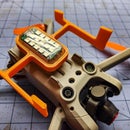Introduction: Dual Diffuser Light Tunnel
Let’s start by saying that I really like to build stuff and photograph stuff. I have been shooting Focus Stacking Extreme Macro for several years now and, as have others, have struggled with good diffused lighting. My first attempt at a DIY diffuser was the Starship Light Tunnel Diffuser, https://www.instructables.com/Starship-Light-Tunnel-Diffuser/ . That works very well but, I found that I needed light from beneath the subject and had to compromise the setup just to light the underside. What I really wanted was a diffuser with diffusion near 360° around the subject.
With that in mind I setout to design a new diffuser. The criteria was;
- Dual layers of diffusion material the same as the Starship Diffuser.
- · Mounted from the Lighting Cage or from the table top the system sits on via a 1/4”Ø x 20tpi threaded mount.
- · Large enough to allow the diffuser to extend over the lens, Nikon 50mm size at least.
- · Uses 3D printed parts to support and stabilize the diffuser.
After about 5 different attempts I finally came up with the Dual Diffuser Light Tunnel System described here.
Supplies
- · 3D Printer
- · Hot Glue Gun
- · Spray glue
- · Metric Ruler
- Flexible Plastic Cutting Board, Neutral with matt finish, 0.016” to 0.03” thick, min. 12”x15” rectangle. or Polypropylene stress relieved sheet .03” thick that’s a min. of 24”W x 48L” with both side matte https://www.eplastics.com/PRONAT-03X24X47M-M.
- Gorilla Tough & Clear Double Sided Mounting Tape, 1" x 60" (Amazon or Walmart)
- Walmart “Pen+Gear” Foam Cushion 12”x20’
Step 1: 3D Print the Base Plate and the Spacer
- The first step is to use the slicer of your chose to prepare both the attached .stl files -Tunnel Base.stl and Tunnel Spacer.stl for 3D printing.
- Print the gcode files you just created using Black filament on a 3D printer. Do not use any other color filaments as they may reflect a strange color onto your subject.
- Using a ¼” x 20 tpi tap, tap the hole in the mounting block. Make sure you don’t tap too deep because the tap will run through the diffuser slot and into the next retainer ring and damage it.
Step 2: Cut Diffusion Material to Size
- · Cut the cutting board material into 2 strips, one 280mm x 110mm and one 350mm x 110mm.
- · Cut the Duck Foam into 2 strips, one 270mm x 95mm and one 340mm x 95mm.
Step 3: Forming the Tunnel
- · Draw a line on each end of the cutting board strips 10mm in from the ends.
- · Placing the ruler on the line fold the 10mm part up 90°. Pivot the sheet around and do the same on the other end. These folds are to relieve the stress on the double sided tap when the you form the tunnel.
- · Flip the sheet over and apply a 10mm wide strip of the double sided tape to one of the folded ends.
- · Lay the sheet on the table with the folds sticking up and the tape facing down.
- · Lift both ends rolling the sheet into a tube.
- · Carefully align the ends to the 10mm marks and press the ends together.
- · Align and stick the rest of the tape joint. Apply pressure along the entire length to make sure the tape sticks.
- Repeat with other diffuser.
Step 4: FINAL ASSEMBLY
- · Insert the small tunnel into the 3D printed Base Plate. Hold it down tightly and use a hot glue gun to tack the tunnel into the Base.
- · Apply spray glue to one side of the small piece of foam packing material.
- · Starting at the tape joint attach the foam packing material to the outside of the inter diffuser.
- · Trim the foam at the joint to make it look solid.
- · Repeat the above process with the outer diffuser.
- · Insert the spacer ring between the two diffusers at the open end.
- · Fix the spacer in place with some hot glue between the diffuser and the spacer.















